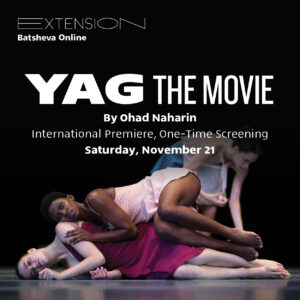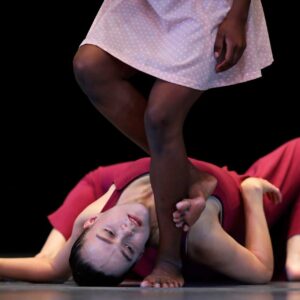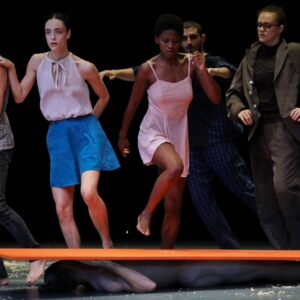A family portrait immersed in dance and death. Review YAG Batsheva Dance Company
SOME TIME
MY FAMILY
LOVED,
REALLY LOVED,
REALLY LOVED
... DANCE
On November 21, 2020, the world premiere of the YAG dance film by Batsheva Dance Company took place . It is worth mentioning at the outset that YAGit is not a new performance by Ohad Naharin. The stage premiere took place in 1996 in Israel, and the show returned to the boards in 2016. This production was recorded in October 2020 at the Suzanne Dellal Center in Tel Aviv. This unique realization was possible thanks to the cooperation of the choreographer with the video artist Roee Shalti as part of the pandemic program "BATSHEVA EXTENSION", the aim of which is to extend the group's activities limited by the restrictions of the repertoire to the online formula. Thus, the reviewed premiere was not a retransmission of the play in the traditional sense. The world audience of over four thousand people was presented with a rather new composition, in which the image presented to the audience allowed them to experience a special closeness and intimacy of the world created by the dancers.
The dominant YAG components were minimalism and a sleepy, disturbing atmosphere. Economical art, almost uniform lighting, simple set design, unobtrusive sound layer, tasteful and thrilling, but not "dance" choreography and general lack of open-air, in my opinion, are the great assets that allowed to show what is most important - the content of the message addressed to viewer. Dramaturgy at YAGit was carried out non-linearly, but consistently, while maintaining logical coherence. The binding motif was the deliberate repetitions and the text spoken by the dancers. It was he who introduced the audience to the family history, which is the main axis of the narrative. An untypical procedure for Naharin's works was setting dancers in specific roles, just like in a drama theater. In this way, on the stage we could see the basic social cell consisting of grandfather, mother, father and three children. All those who face the tragedy of death.
The performance was started by the charismatic Hani Sirkis. In a sparse and looped, even hypnotic, movement sequence, she uttered words in Hebrew, the transcription of which appeared in parallel in English: My name is Hani. I have a brother and a sister. My sister's name is Londiwe. My brother's name is Sean. My mother is dead. My father is also dead. I never met my grandfather. The choreography was joined in turn by a stage sister, danced by Londiwe Khoz, and brother, Sean Howe. It is worth noting that the dancers used their real names, which added realism to the stage, clearly dreamlike reality. The parents of Yael Ben Ezer and Igor Ptashenchuk lay motionless on the floor, dead. The whole scenery was a red object evoking associations with the door, but, what is important, without a handle. Perhaps it was a door beyond which there is no return to the world of the living. From behind this space, my grandfather emerged, played by Yoni Simon, the sixth and last dancer to appear in YAG. The costumes developed by Eri Nakamura were culturally universal and kept in a rather subdued aesthetic. The colors were faded as if lifeless. However, the author used a clear codification in terms of gender and the roles of the characters. The daughters wore polite styling, the mother wore an evening dress, the father wore a suit, the son wore nondescript pants and a T-shirt, and the aforementioned grandfather, pajamas. Just like in a classic family photo or portrait that each of us can associate. It gave the entire story a universal dimension and at the same time made it impossible to place it in a specific time-space context. The prologue was a clear introduction to the semantic structure of the performance. The visual means used, tension-building music and trance,the disturbing movement could evoke associations with the abyss presented in Christian symbolism - the conceptlimbus puerorum formulated by St. Thomas Aquinas, a state of suspension of the soul after death. This motif is clearly outlined throughout the performance, but the use of dance as a leading counterpoint gave the work the necessary lightness, as well as dramatic depth and abstract dimension, thus multiplying the multitude of interpretations. The opening ends with a pose for the aforementioned family portrait. There are also words that were repeated like a prayer by each dancer during the performance: Once upon a time. My family. She loved. She really loved it. She really, really loved… dancing. Said for the first time, this phrase started a series of dynamic group scenes, filled with animalism and a strongly articulated language of movement. The dancers shifted levels and directions in full sync as if they had been released from their constraining bonds. It is impossible not to mention the phenomenal performance quality of the artists from the Batsheva Dance Company. Their specific, and at the same time phenomenal, magnetic way of conducting the movement gave the impression of being unreal, which corresponded to the dark character of the performance. In consecutive constellations, the performers from the group contact moved successively into more intimate but equally endearing solo scenes as well as duets and trios, taking viewers on an emotional journey. The way the camera was guided and the editing added intimacy,thanks to which we witnessed not only great choreographic sequences, but also close-ups of faces and gazes, showing details and giving authenticity to the created characters. Each subsequent edition was a precise, movement commentary on the relationships within the family affected by the tragedy of death. It is certainly worth mentioning the poignant scene of fortune cookies, which - in my reading - touched upon the issue of premature departure or taking life away by ruthless Fortune - the goddess of happiness and misfortune, in Roman mythology, who controls human fate. The multiplication of the sound of this cracking turned into the sounds of a storm bringing irreversible changes. I also remember the change of roles when my mother changed into his suit after my father disappeared.Perhaps to take over his functions in the family, while he was lying naked, covered with the only element of the scenery, like in a coffin, with a red door. Analyzing the topic from a broader, humanistic perspective, inYAG, you can find a systemic approach to family thinking that derives from Aristotle's assumption that the whole is more than the sum of its parts . The family is thus treated as a new being, a system in which each individual affects all other members of the family system, and a change in one element causes a change in the entire system. At the end, Naharin used a composition bracket, which was preceded by a scene of uninhibited dancing contrasting with the weight of the situation. The dancers launched a groove within themselves, a characteristic element of the choreographic language visible in other works of Batsheva. The final painting is a return to the family portrait. This image, however, was distorted by the image of a naked father who, at the last moment, crawled over to his relatives to pose with them. It was as if his death hadn't made him leave them. In my opinion, it was a very eloquent and powerful ending, perfectly closing the dramatic structure.
YAG's stage premiere took place 24 years ago, but due to the universality of the issues raised, the show did not age. While encouraging you to watch this dance movie, it is worth emphasizing that above all the tragedy, it is primarily a story about a love of dance and an attempt to transform difficult emotions into movement, which is probably Ohad Naharin's personal message.
Marek Zadłużny
Kwartalnika Taniec
24 December 2020
YAG
Batsheva Dance Company
Director: Ohad Naharin
Recording: Roee Shalti
Editing: Roee Shalti and Ohad Naharin
Costumes: Eri Nakamura
Lighting Design: Avi Yona Bueno (Bambi)
Music: John Zorn, Gaetano Donizetti, John Taverner, Ennio Morricone, Ran Slavin
Text: Ohad Naharin, Dan Timor “Me and My Little Sister” (Am Oved Publishers Ltd., 2003) as read by Tommy Shles Shafrir.
Batsheva Dance Company dancers perform in the 2020/2021 season:
Yael Ben Ezer, Sean Howe, Londiwe Khoza, Igor Ptashenchuk, Yoni (Yonatan) Simon, Hani Sirkis





